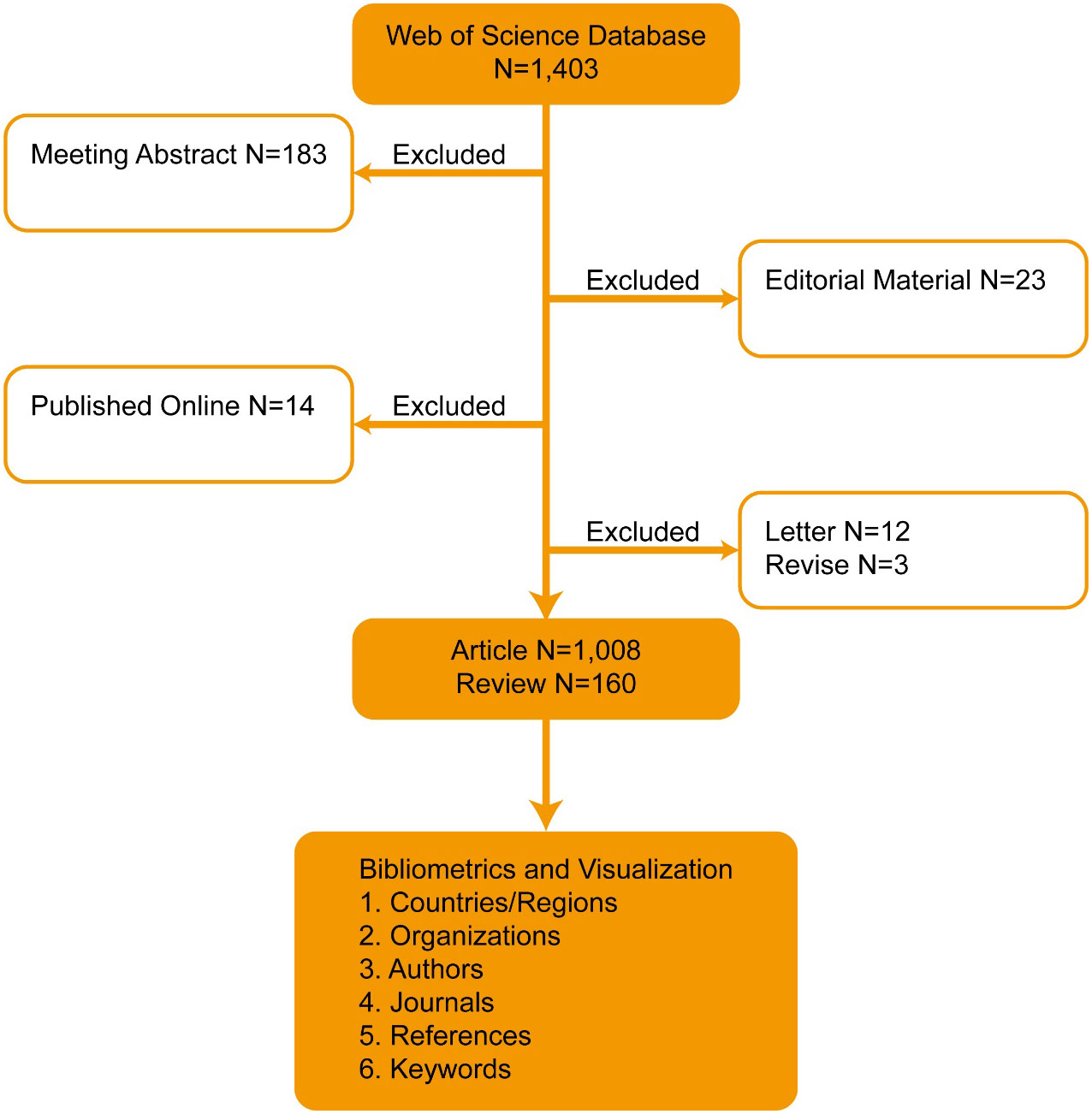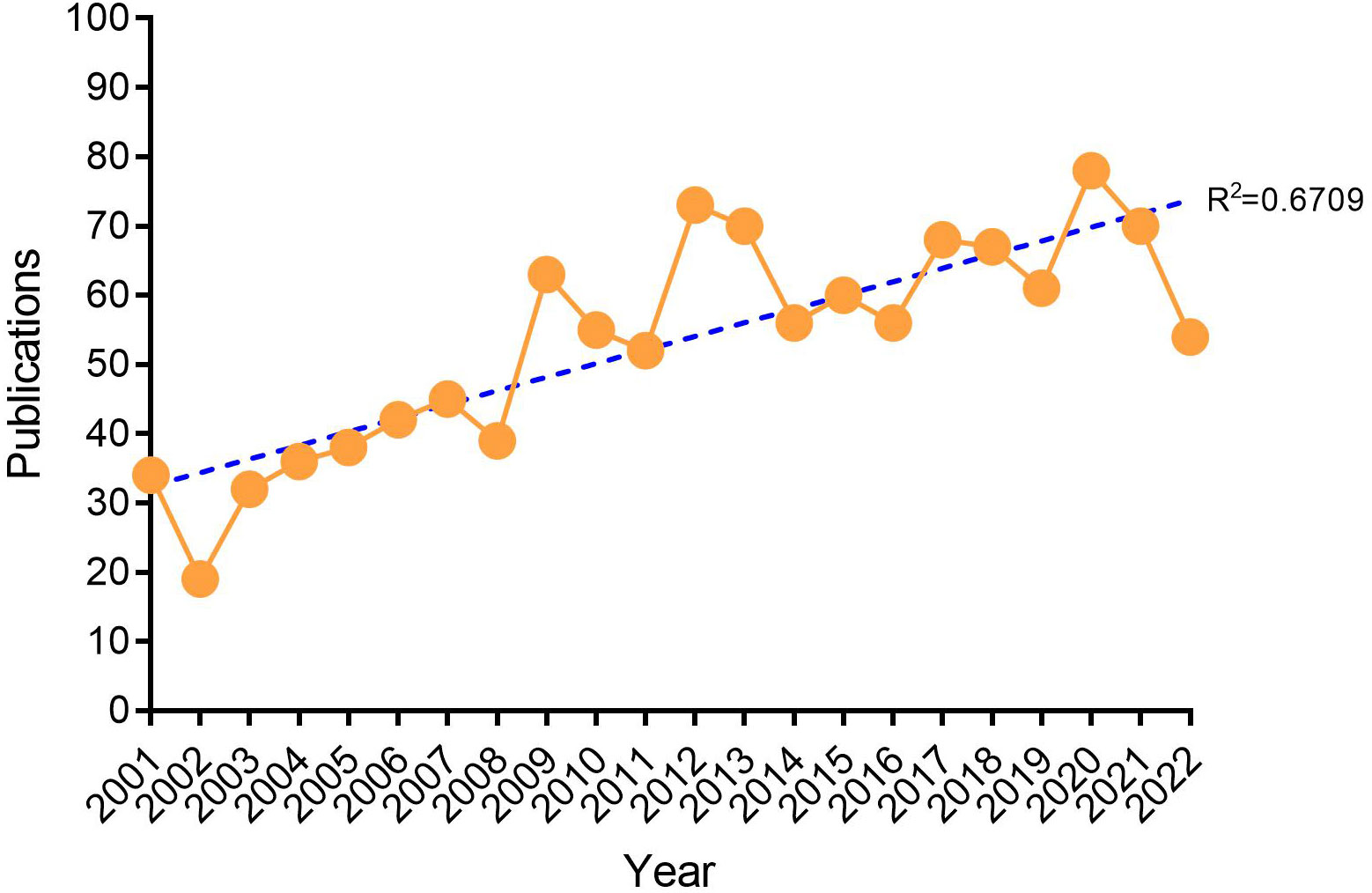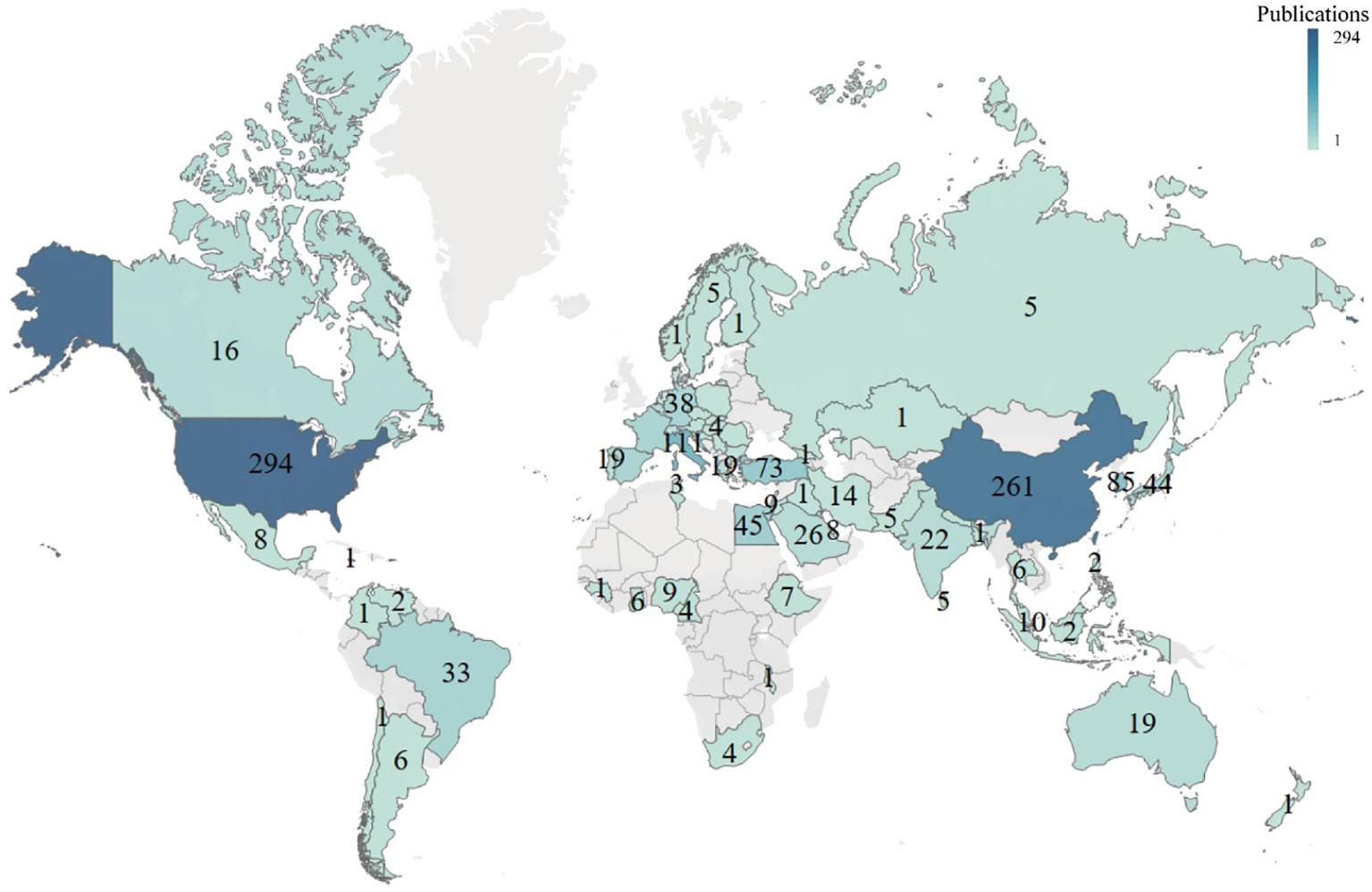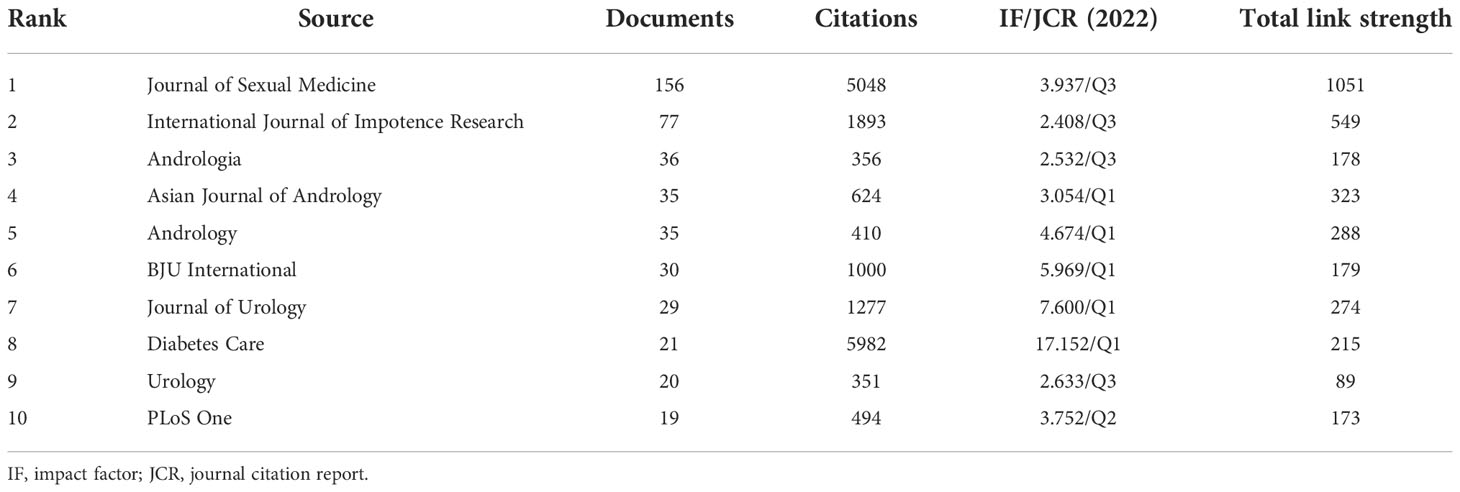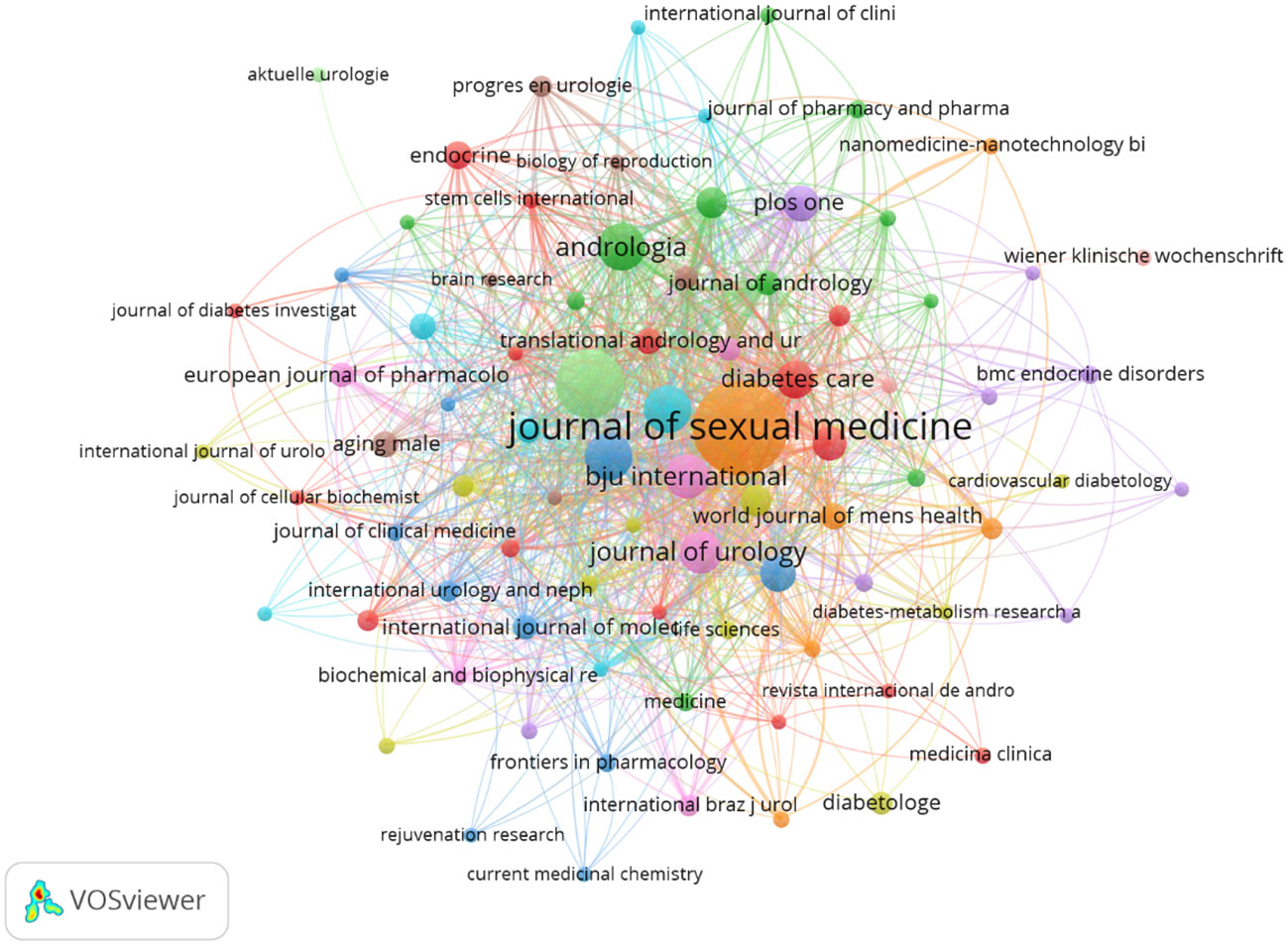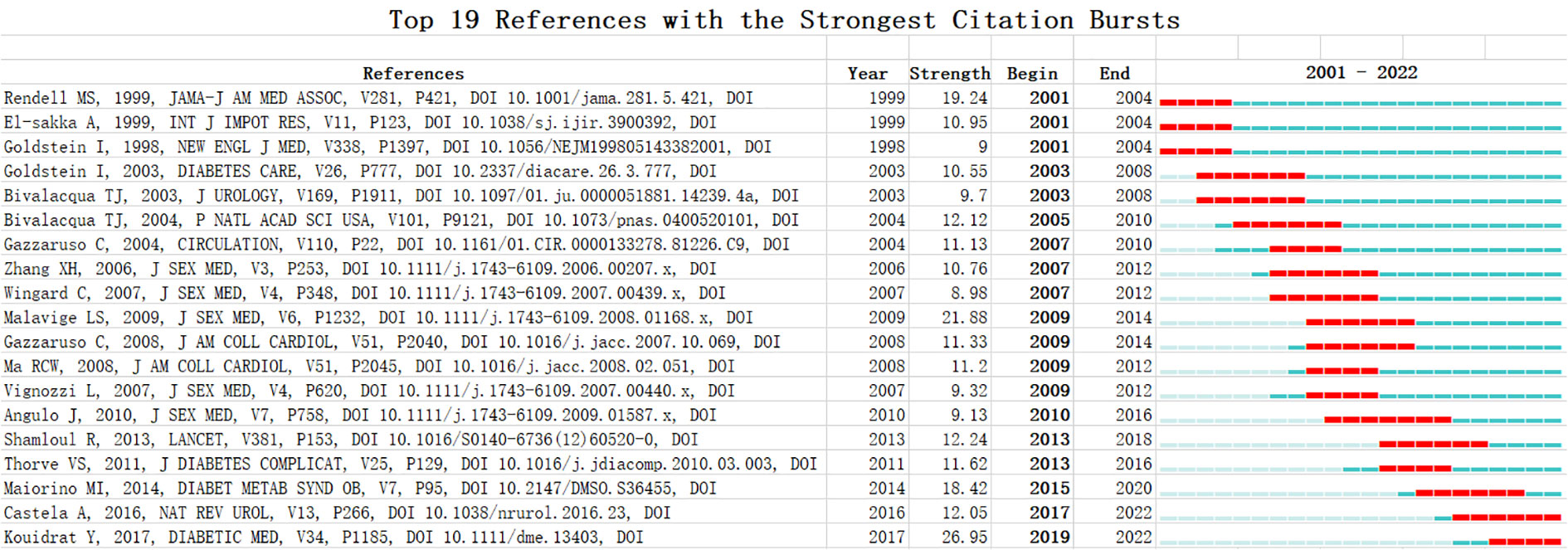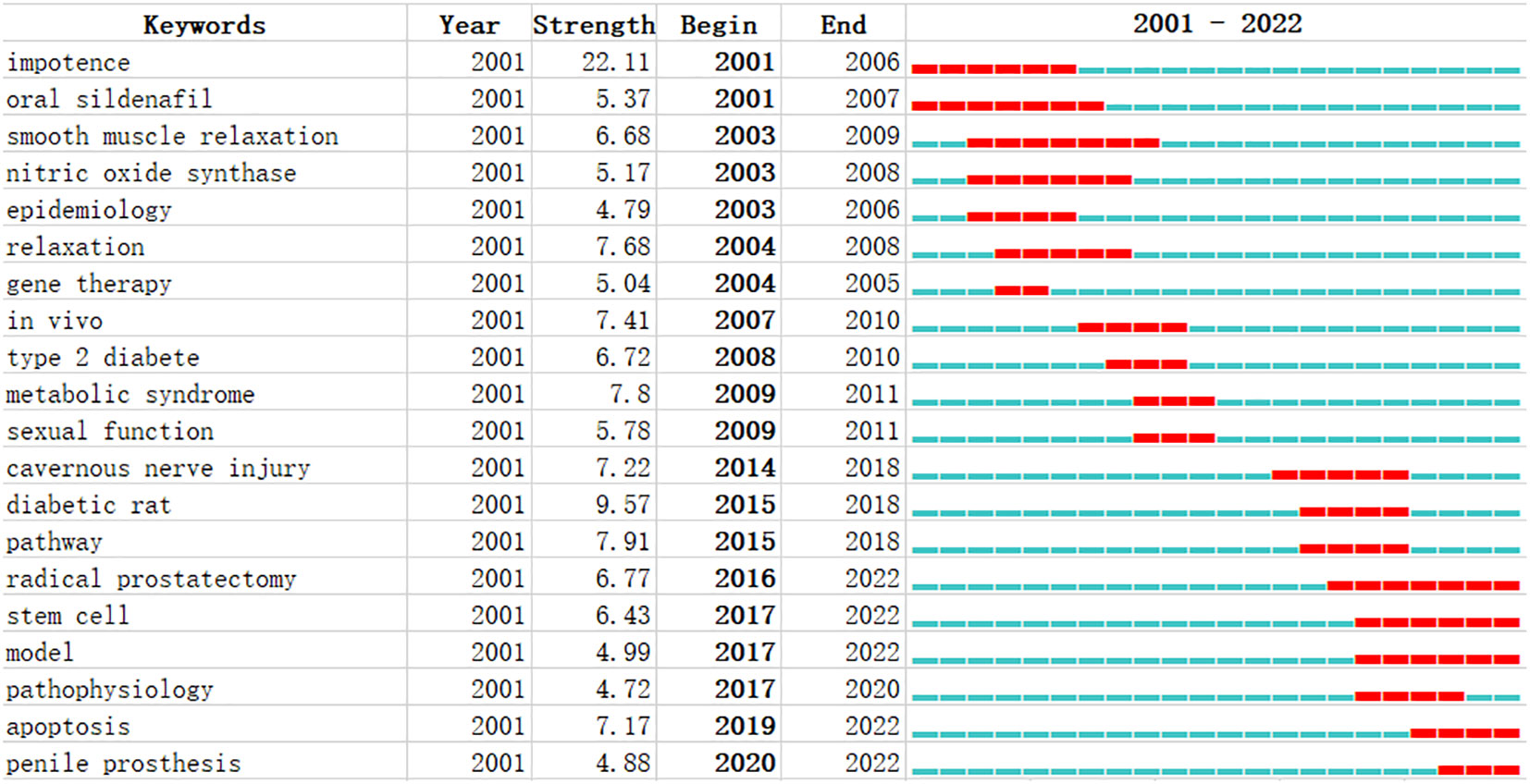- 1Urology Surgery, The Third Affiliated Hospital of Beijing University of Chinese Medicine, Beijing, China
- 2Department of Nephroendocrinology, Dongzhimen Hospital, Beijing University of Chinese Medicine, Beijing, China
- 3Department of Andrology, Shunyi Hospital, Beijing Hospital of Traditional Chinese Medicine, Beijing, China
- 4Department of Surgery, Beijing Xuanwu Traditional Chinese Medicine Hospital, Beijing, China
- 5Department of Andrology, Dongzhimen Hospital, Beijing University of Chinese Medicine, Beijing, China
Introduction: Diabetic erectile dysfunction (DMED) refers to erectile dysfunction secondary to diabetes. Erectile dysfunction is characterized by a persistent inability to achieve and maintain an erection sufficient to permit satisfactory sexual activity.
Methods: Based on the Web of Science core collection database, we firstly analyzed the quantity and quality of publications in the field of DMED, secondly profiled the publishing groups in terms of country, institution, author’s publication and cooperation network, and finally sorted out and summarized the hot topics of research.
Results: From 2001 to 2022, a total of 1,403 articles relating to this topic were published in 359 journals. They represent the global research status, potential hotspots, and future research directions. The number of DMED-related publications and citations has steadily increased over the few past decades. Academic institutions from Europe and the United States have played a leading role in DMED research. The country, institution, journal, and author with the most publications were the United States (294), INHA University (39), the Journal of Sexual Medicine (156), and Ryu, Ji-Kan (29), respectively. The most common keywords were erectile dysfunction (796), men (256), diabetes (254), diabetes mellitus (239), prevalence (180), corpus cavernosum (171), dysfunction (155), mellitus (154), nitric-oxide synthase (153), and expression (140). The main keyword-based research topics and hotspots in the DMED field were oral sildenafil, smooth muscle relaxation, nitric oxide synthase, gene therapy, metabolic syndrome, cavernous nerve injury, stem cell, and penile prosthesis.
Discussion: The terms oral sildenafil, smooth muscle relaxation, nitric oxide synthase, gene therapy, metabolic syndrome, cavernous nerve injury, stem cell, and penile prosthesis will be at the forefront of DMED-related research.
Introduction
Diabetes is a chronic, non-infectious disease caused by both genetic and environmental factors. Over the past three decades, the number of people with diabetes worldwide has more than doubled, making it one of the most important global public health challenges (1). Erectile dysfunction is defined as the persistent inability to achieve and maintain sufficient erectile capacity to permit satisfactory sexual behavior (2). Diabetic erectile dysfunction (DMED) refers to erectile dysfunction secondary to diabetes mellitus (3). The incidence of erectile dysfunction ranges from 0.1% to 18% in the normal population but is nearly three-fold higher in patients with diabetes, and affected people tend to be younger (4).
There is evidence for a link between diabetes and the development of erectile dysfunction in both animal models and humans (5). The central nervous system and pericardial nerve damage caused by a high-glucose environment is an important cause of DMED (6). In addition, age, duration of diabetes, blood glucose control, smoking, hypertension, atherosclerosis, adverse drug reactions, and psychological factors are all closely related to the occurrence of DMED. Current treatment methods for DMED can be summarized as primary disease treatment, psychological treatment, and symptomatic treatment.
The term bibliometrics was coined by Alan Pritchard in 1969 (7). Bibliometric analysis is a powerful tool that uses literature measures or indicators to quantify research performance in a given field (8, 9). CiteSpace and VOSviewer are commonly used processing tools for visualizing research impact based on co-word, co-citation, and literature-coupling analysis (10).
Based on the advantages of clustering technology and map presentation, the research trend of any given field can be analyzed and displayed as a multivariate, comprehensive, visual knowledge map (11, 12). Using such bibliometric software, literature related to DMED in recent decades can be visually displayed and analyzed. Accordingly, with Scopus as the data source, we utilized CiteSpace, VOSviewer, and Microsoft Excel to show the knowledge base, development trends, and emerging hotspots in the DMED field.
Materials and methods
Ethics statement
No approval was required from the Institutional Review Board as data were retrieved from the Web of Science (WOS) database (https://www.webofscience.com/wos/woscc/basic-search) and no human subjects were involved.
Sources and collection
The WOS is the most commonly used database in scientific and bibliometric research. It contains nearly 9,000 of the world’s most prestigious high-impact journals and more than 12,000 academic conferences, thus providing a comprehensive overview of the global research results in science, technology, medicine, and other fields (13, 14).
Publication information in the DMED area was searched within one day to ensure that no data were updated. The period was January 1, 2001, through September 30, 2022, and the retrieval date was October 1, 2022. The WOS Core Collection was selected, the subject words were “Diabetic erectile dysfunction”, and the article types were “article” and “review”. The retrieved results were exported in “Plain text file” format, and “Full Record and Cited References” was selected for “Record content”.
The search query string was described as follows: Results for “diabetic erectile dysfunction” (Topic) and Article or Review Article (Document Type) and Book Chapters (Exclude - Document Type).
Bibliometric analysis and software
CiteSpace software (Drexel University, Philadelphia, PA, USA), designed by Dr. Chen Chaomei in 2004 (11), is a freely available Java application widely used for the visualization and analysis of trends and patterns in scientific literature (15). CiteSpace (https://citespace.podia.com/download, R6.1.3) to scientometrics, data and information visualization technology as the foundation, through the analysis of the potential knowledge of literature, regularity and distribution, present knowledge structure. In this study, CiteSpace was used for keyword clustering and salient word analysis.
VOSviewer 1.6.18 (https://www.vosviewer.com/) is a software tool for constructing and visualizing bibliometric networks (16). In this study, VOSviewer was used to visualize countries/regions, authors, institutional collaborations, citations, and keyword co-occurrence, as well as to construct density maps.
The aim was to describe all the literature characteristics, including country/institution, journals, highly cited articles, cluster network of co-cited references, and most frequently cited keywords. In particular, in addition to noun phrases extracted from article titles and abstracts, burst detection was applied to the keywords of publications in the article collection assigned to the citation extension.
Results
Time trends in publications and citations
The number of annual publications is an important parameter for evaluating the development of scientific research and can reflect the growth of knowledge in this field to a certain extent. As of September 30, 2022, a total of 1,403 publications related to DMED were published (Figure 1). The number of articles published per year is shown in Figure 2. Although the trend was upward overall, it fluctuated slightly in some years. Notably, the number of publications per year can be easily divided into two phases. In the first phase, from 2001 to 2008, the average number of publications per year was around 30; in the second phase, from 2009 to 2022, the average number of publications per year stabilized at more than 50. Overall, the amount of knowledge in the DMED research field showed a linear growth trend (R2 = 0.6709), reflecting the increasing research interest in this field.
Analysis of the most productive countries/regions
A total of 75 countries/regions have published articles in this field. The 10 countries that made the most significant contributions to DMED-related publications were the USA (294), China (244), Italy (111), South Korea (85), England (79), Turkey (73), Egypt (45), Japan (44), Spain (40), and Germany (38) (Figure 3; Table 1). The size of the nodes is determined by the number of publications (the larger the number, the larger the node). The same colors represent the same clusters. The lines between nodes represent the alignment between countries/regions (the stronger the partnership, the wider the boundaries). The total link strength reflects the combined strength between countries/regions. As shown in Table 2, the USA had the largest number of publications, the highest number of citations (15,620), and the greatest link strength (164). The USA (15,620), Italy (6,917), England (6,645), China (4,495), and Germany (2,381) were the top five countries in terms of citations. The above results indicated that these countries exerted the greatest influence on DMED-related research.
VOSviewer was used to analyze cooperation across countries, with lines between nodes indicating co-authorship between countries (the thicker the line the stronger the cooperation). China, the USA, Italy, South Korea, and England cooperated the most with other countries (Figure 4).
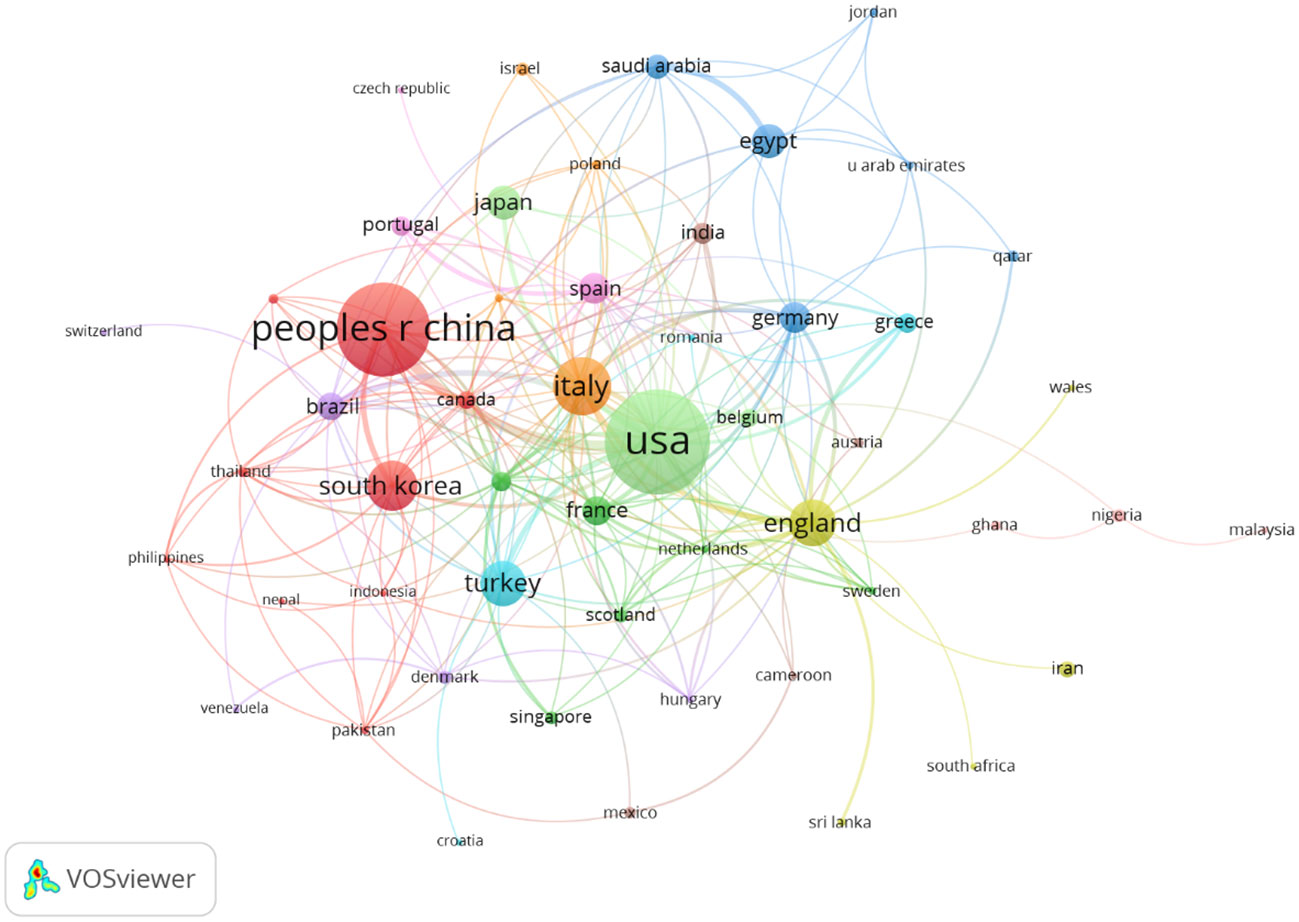
Figure 4 Co-occurrence map of countries/regions. The size of the nodes represents the number of articles. The thickness of the curves represents the strength of collaboration. The colors represent different collaboration groups.
Contributions of the top organizations
A total of 1,465 institutions participated in the publication of papers related to DMED technology. The 10 institutions that contributed the most to DMED publications were INHA University (39), Huazhong University of Science & Technology (32), Tulane University (29), University of California San Francisco (25), Peking University (23), Seoul National University (20), Cairo University (20), University of Florence (19), Nanjing University (19), and Southern Medical University (18) (Table 3). These results demonstrated that INHA University had the greatest number of publications with the highest number of citations (663) and the greatest link strength (20). Each node represents a different institution. The size of the node is determined by the number of publications (the larger the number, the larger the node). The same colors represent the same clusters. Boundaries between nodes represent a collaboration between organizations (the stronger the partnership, the wider the boundaries). The total link strength reflects the aggregate strength between institutions. As can be seen from the map, 146 institutions actively cooperated both within and between clusters. The three institutions with the highest total link strength were Peking University (34), the University of Florence (24), and the University of California San Francisco (23). The five institutions with the greatest number of citations were Eastern Virginia Medical School (4,067), Harvard University (3,845), The University of Pavia (2,092), the University of Manchester (1,684), and the University of Rome Tor Vergata (1,558) (Table 4). Tulane University, University of Florence, University of California San Francisco, INHA University, and Huazhong University of Science & Technology were at the center of such collaborations. However, most institutions were fragmented and displayed little cooperation (Figure 5).

Figure 5 Co-occurrence map of institutions. The node size represents the number of articles; the curve thickness represents the strength of collaboration; the different collaboration groups are sorted by color.
Analysis of authors and co-cited authors
Author co-occurrence analysis can identify the core authors in a field and the strength of collaboration among authors. Co-citation means that two authors or papers are cited by a third author or paper at the same time. This study included 5,216 authors and 20,297 co-cited authors. Of these, Ji-Kan Ryu (29), Jun-Kyu Suh (29), Wang Tao (26), Yin Guo Nan (25), and Liu Jihong (20) published the most articles (Table 5). At the same time, Jihong Liu and Guiting Lin obtained the most cooperation, forming two stable author cooperation groups (Figure 6). However, there was a lack of cooperation among other authors and teams, and the research was in a relatively scattered state. The results of the co-citation relationship showed that Bivalacqua, TJ (430); Corona, G (340); Feldman, HA (259); Rosen, RC (258); and Burnett, AL (213) were the most frequently cited authors (Table 6), indicating that they play an important role in DMED research.
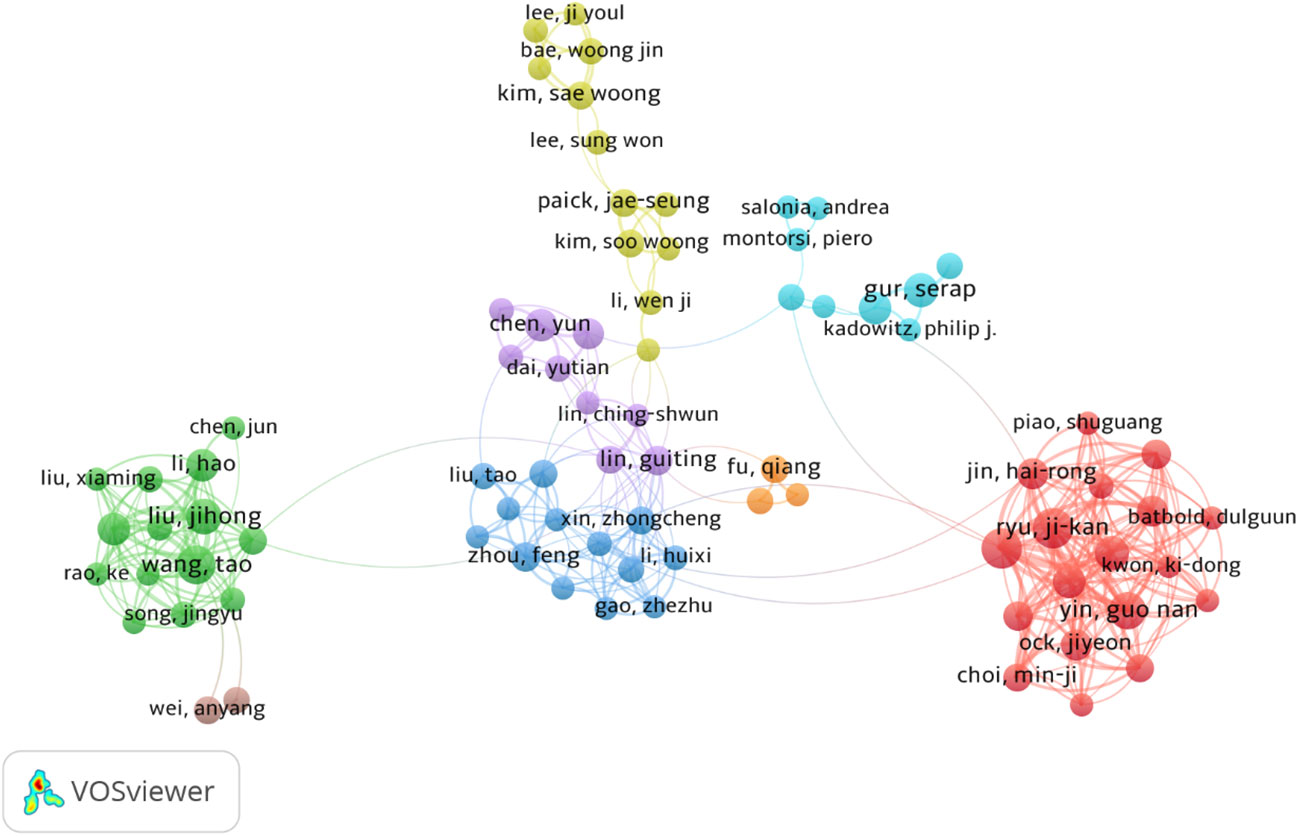
Figure 6 CiteSpace visualization map of authors involved in publications related to assisted reproduction. Nodes represent authors (the larger the circle, the greater the number of publications). The lines between nodes represent the cooperation between two authors of the same article (the wider the line, the more frequent the cooperation). The node color represents the year.
Journal distribution
The selected papers were published in a total of 359 journals. The 10 journals with the most publications were the Journal of Sexual Medicine (156), the International Journal of Impotence Research (77), Andrologia (36), the Asian Journal of Andrology (35), Andrology (35), BJU International (30), the Journal of Urology (29), Diabetes Care (21), Urology (20), and PLoS One (19) (Table 7; Figure 7).
A total of 4,634 journals were identified as being co-cited. The top five co-cited journals were the Journal of Sexual Medicine (3,656), the Journal of Urology (2,878), the International Journal of Impotence Research (2,058), Diabetes Care (1,676), and Urology (997) (Table 8).
Analysis of highly cited and co-cited literature
A total of 1,168 references and 29,269 co-cited references were obtained. Some papers were cited over 300 times, including those by Tesfaye (2010), Boulton (2005), Vinik (2003a), Gallagher (2007), Jurenka (2008), Jones (2011), and Kapoor (2007b) (Table 9). In addition, a total of 19 references were obtained to highlight the analysis results. The three references with the highest intensities were Kouidrat Y, 2017 (doi: 10.1111/dme.13403), citation burst strength: 26.95; Malavige LS, 2009 (doi: 10.1111/j.1743-6109.2008.01168.x), citation burst strength: 21.88; and Rendell MS, 1999 (doi: 10.1001/jama.281.5.421), citation burst strength: 19.24 (Figure 8).
Keyword analysis
Changing trends in research topics over time can be identified through keyword co-occurrence and salience analysis to better grasp the development of research hotspots. A total of 3,969 keywords were obtained, the top 10 of which were erectile dysfunction (796), men (256), diabetes (254), diabetes mellitus (239), prevalence (180), corpus cavernosum (171), dysfunction (155), mellitus (154), nitric oxide synthase (153), and expression (140) (Table 10; Figure 9).
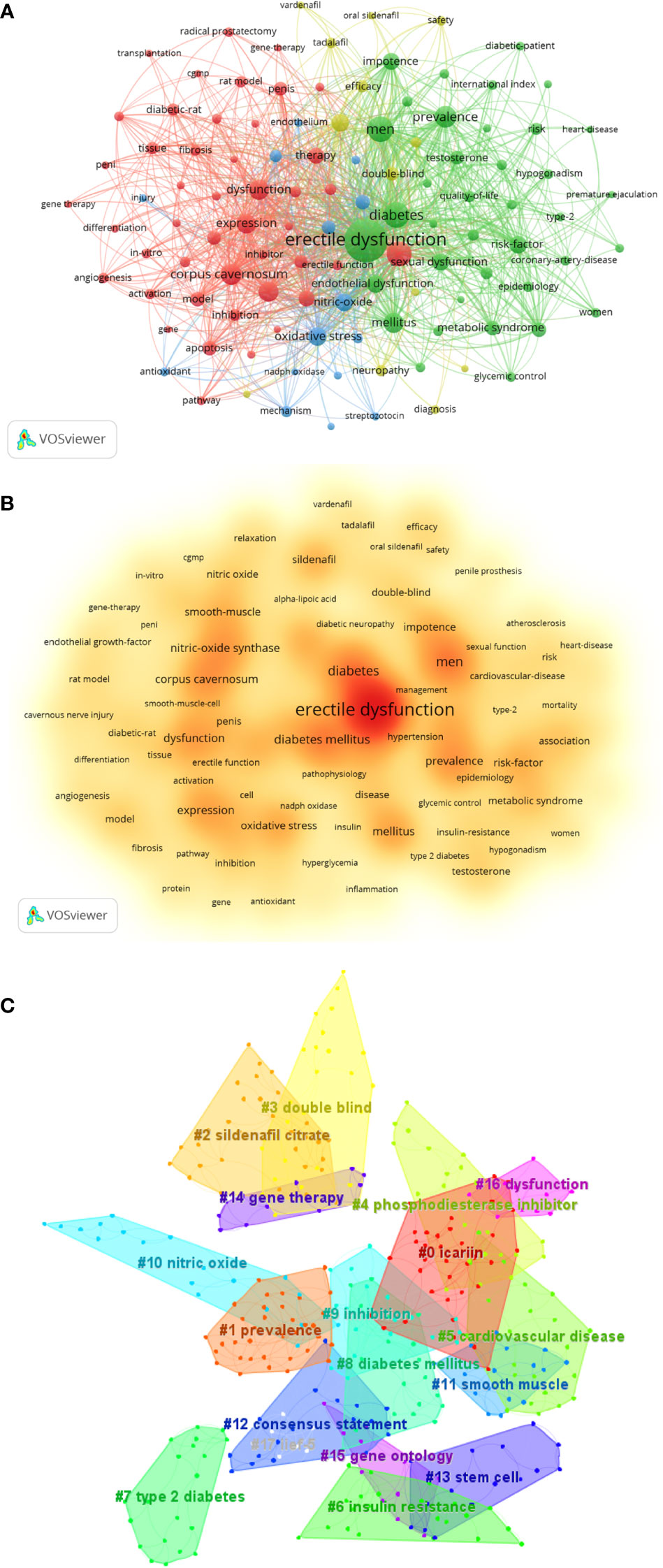
Figure 9 Keyword analysis. (A) Map of the keyword co-occurrence analysis obtained using VOSviewer. The size of the nodes represents the number of occurrences; the thickness of the curve represents the strength of collaboration; the different colors represent the different clusters. (B) Keyword density visualization analysis. The redder the node color, the higher the frequency of the keyword. (C) Keyword clustering map analysis using CiteSpace. A total of 16 categories of keywords were obtained; the different color blocks represent different keyword clusters.
After clustering using CiteSpace software, a total of 18 categories of keywords were obtained. From 2001 to 2011, keyword-based research hotspots in the DMED field mainly included impotence, oral sildenafil, smooth muscle relaxation, nitric oxide synthase, epidemiology, relaxation, gene therapy, in vivo, type 2 diabetes, metabolic syndrome, and sexual function. From 2014 to 2022, meanwhile, the research hotspots (by keyword) included cavernous nerve injury, diabetic rat, pathway, radical prostatectomy, stem cell, apoptosis, model, pathophysiology, and penile prosthesis, among others (Figure 10).
Discussion
Comprehensively and systematically summarizing the research topics, research trends, and global research status relating to DMED allows a rapid preliminary understanding of the research status of this condition. With the advent of big data, researchers need to fully understand the developments in their research field. Different from systematic review or meta-analysis, bibliometric analysis uses visualization software, such as VOSviewer and CiteSpace, to comprehensively analyze the existing literature and obtain an intuitive understanding of the research trends, as well as to predict research hotspots (16). This study is the first to summarize the research status relating to DMED in the past 20 years through bibliometric analysis.
General information about the literature on diabetic erectile dysfunction
Over the past 20 years, the number of DMED-related articles published in journals showed a linear upward trend (R2 = 0.6709).
From the perspective of countries/regions and institutions, the number of publications originating from the United States as well as the number of associated citations far exceeded that of other countries. Although the number of articles published in China ranked second, the number of citations was low, ranking only fourth. This indicates that, although the number of papers from Chinese institutions is increasing yearly, there is still a lack of high-quality articles. This may be partly explained by a lack of cooperation with internationally renowned researchers as well as language barriers. Among the 10 institutions with the most published papers, only Huazhong University of Science & Technology, Peking University, and Nanjing University were from China—with the remainder being mainly from Europe and the USA—and these institutions had low levels of research cooperation. These observations highlight the need to strengthen communication and cooperation with global research teams, especially those from countries and institutions in the Asian region.
Regarding authors and references, Ryu, Ji-Kan and Suh, Jun-Kyu had the greatest production efficiency, while Bivalacqua, TJ had the most co-citations. Corona, G; Feldman, HA; Rosen, RC; and Burnett, AL also made important contributions to DMED research. The research undertaken by Ryu, Ji-Kan and Suh, Jun-Kyu is mostly mechanism-related. The former has mainly focused on identifying potential target genes associated with DMED in mouse cavernous pericytes (17). Meanwhile, Suh, Jun-Kyu found that pericellular-derived extracellular vesicles mimicking nanovesicles can promote neurovascular regeneration and erectile function recovery under diabetic conditions through a lipid chain enzyme 2 (LCn2)-dependent mechanism (18). Both authors reported that the preservation of damaged cavernous neurovasculature through the inhibition of the proNGF/p75NTR pathway may represent a novel therapeutic strategy for radical prostatectomy-induced erectile dysfunction (19).
The Journal of Sexual Medicine published the most DMED-related papers and the 10 most cited and co-cited journals were mainly in Q1 and Q2. This indicates that most papers published in this field were high-quality scientific research achievements.
Hotspots and frontiers
Our analysis further demonstrated that the most influential authors and references were mostly associated with review articles and clinical guidelines from internationally renowned institutions and journals. Combining keyword co-occurrence, clustering, and salience analysis, we identified oral sildenafil, smooth muscle relaxation, acute oxide synthase, gene therapy, metabolic syndrome, cavernous nerve injury, stem cell, and penile prosthesis as the main research topics and hotspots in the field of DMED.
The main treatment for erectile dysfunction is drug therapy, including phosphodiesterase-5 (PDE5) inhibitors, androgen therapy, and vasoactive drugs (20–22). PDE5 inhibitors, such as sildenafil, tadalafil, and vardenafil, are the first-line oral drugs recommended by the World Health Organization (WHO) for the treatment of erectile dysfunction, including that associated with diabetes (23–25). These drugs increase the concentration of cyclic guanosine monophosphate (cGMP) in vascular smooth muscle cells by inhibiting PDE5 expression in the corpus cavernosa, reduce the concentration of intracellular calcium, cause smooth muscle relaxation, increase blood flow to the corpus cavernosa, and improve erection. Treating DMED with a PDE5 inhibitor can improve the International Index of Erectile Function-5 (IIEF-5) score and sexual success in a significant number of patients (26, 27).
Nevertheless, PDE5 inhibitors are ineffective in patients with severe erectile dysfunction (28) and are occasionally associated with side effects such as headaches, flushing, indigestion, nasal congestion, vision abnormalities, and diarrhea. The prerequisite for PDE5 inhibitor to function is that ED patients must have intact molecular and neurological pathways and some degree of sexual stimulation. Therefore, PDE5-Is has poor efficacy in patients lacking upstream nitric oxide (NO) pathway (29) in some disease states, such as diabetes with peripheral neuropathy (30) and prostate cancer (31). In addition to drugs, other alternative strategies are available, such as vacuum contractile devices and penile prosthesis implantation The three-piece inflatable penile prosthesis (IPP) is the most common implant used in penile surgery (32).The satisfaction rate of patients is 90% ~ 100%, which varies with different prosthesis devices (33, 34).However, IPP may only be offered to patients who fail due to the high cost of conservative treatment, its invasive nature, and myriad potential complications. Thus, novel therapeutic approaches are urgently required to overcome these disadvantages in DMED treatment.
Stem cell therapy has attracted increasing attention owing to its ability to promote functional recovery and tissue structural repair in patients with diabetes. Stem cell mainly include bone marrow mesenchymal stem cells (BMSCs) (35), adipose-derived stem cells (ADSCs) (36), neural derived stem cells (37), mesenchymal stem cells (MSCs) (38), umbilical cord derived stem cells (39) and urine-derived stem cells (USCs) (40).Mesenchymal stem cells (MSCs) are adult stem cells derived from mesoderm with a high potential for proliferation, self-renewal, and multidirectional differentiation (41). The culture of bone marrow-derived MSCs is relatively simple; accordingly, they are widely used in animal studies and clinical trials (42). Given their abundant autologous availability, MSCs are one of the most promising candidates for the treatment of DMED (43). Importantly, allogeneic MSCs can also be successfully transplanted owing to the low immunogenicity (44, 45). In animals, bone marrow-derived MSC transplantation can significantly improve the recovery of erectile function by inhibiting apoptosis (46). For DMED, MSC-based treatment has also attained encouraging therapeutic effects (47). The restoration of erectile function is mainly attributed to the increased endothelial cell and smooth muscle content in the corpus cavernosum (48, 49). Various strategies have recently emerged to improve the therapeutic effect of MSCs on DMED (50, 51).In a single-blind study, 6 out of 7 ED patients developed morning erections 3 months after treatment with umbilical cord derived stem cells (39).Chen S et al. found that adipose mesenchymal stem cells were more effective in treating diabetes-related erectile dysfunction than bone marrow mesenchymal stem cells (52).
Erectile dysfunction has been associated with the upregulation of Toll-like receptor 4 (TLR4) expression. It has been reported that TLR4 expression is significantly increased in the corpus cavernosum of diabetic rats compared with that of controls (53). The overexpression of inducible nitric oxide synthase (iNOS) may also be associated with penile microvascular dysfunction in diabetes mellitus, while endotoxemia has been linked with iNOS upregulation (54). Studies on conducting vessels have shown that iNOS overexpression in endotoxemia contributes to endothelial dysfunction by reducing the activity of endothelial nitric oxide synthase (eNOS) (55). iNOS inhibitors can alleviate DMED-related injury by moderating eNOS phosphorylation and chronic iNOS overexpression as well as improving microvascular fibrosis (56).
Trabecular smooth muscle relaxation during sexual stimulation and dilatation of penile resistance arteries in the cavernous body are essential for penile erection (57). Nitric oxide (NO) is a key factor in both processes. NO can be released from nerve endings or endothelial cells to stimulate cGMP production in penile smooth muscle cells, relaxing them and increasing blood flow to the corpus cavernosum (58, 59). Defects in the NO/cGMP pathway at any level will lead to inadequate penile smooth muscle relaxation, which affects erectile function (60).
In vitro low-intensity shockwave therapy (LI-SWT) is a potential treatment option for ED. The micro-damage of Li-SWT to the spongy tissue may stimulate neovascularization and up-regulate some factors related to tissue healing and remodeling (61).A prospective, randomized, sham controlled study reported a clinically significant improvement in erectile function in 40.5% of the treatment group based on the minimum clinically significant difference (MCID) criteria (62).Another randomized clinical trial evaluated changes in penile hemodynamics and IIEF-EF scores in patients with vascular ED. In the IIEF-EF score, 56.7% of the treatment group achieved MCID at 1 month and 75% achieved MCID at 12 months (63).
Through keyword co-occurrence and salience analysis, we also found that there is a regional imbalance in the development of DMED research and influential authors and institutions are mainly concentrated in Europe and Asia, which may be due to greater research interest. Additionally, despite the numerous studies undertaken on DMED, the underlying mechanism remains incompletely understood and represents a key future research direction.
Limitations and prospects
To the best of our knowledge, this is the first bibliometric analysis of DMED-related studies undertaken in the last 20 years. However, our study still had some limitations. First, high-quality articles published in recent years may not have yet reached the ideal citation threshold, which may have introduced research bias. Second, there may be a delay in exploring the frontiers of research. Finally, we only included literature written in English from the WOS, which may have resulted in the omission of important documents in other languages.
Conclusions
Overall, our bibliometric analysis provides comprehensive information on DMED-related publications. Our findings suggested that the field of DMED is thriving and has stimulated great interest in the research community worldwide. Although DMED is a relatively common disease, much remains unknown about both the underlying mechanisms and how to treat it. Likely, the terms oral sildenafil, smooth muscle relaxation, nitric oxide synthase, gene therapy, metabolic syndrome, cavernous nerve injury, stem cell, and penile prosthesis will be at the forefront of DMED-related research.
Data availability statement
The original contributions presented in the study are included in the article/supplementary material, further inquiries can be directed to the corresponding authors.
Author contributions
FM and HL (10th author) designed the study. XL, HC, LW, MZ, HL (7th author), GG and DL conducted the literature search. FM, XL and LW analyzed the data and wrote the paper. FM and JW approved the final manuscript. All authors contributed to the article and approved the submitted version.
Funding
China Postdoctoral Innovative Talent Support Program (BX20220047); China Postdoctoral Science Foundation (No. 2022M720528); Young Talent Support Project of Beijing Association of Science and Technology (BYESS2022182); Young Talent Support Project of Chinese Association of Chinese Medicine (CACM-2021-QNRC2-B04); The National Natural Science Foundation of China (82174385).
Conflict of interest
The authors declare that the research was conducted in the absence of any commercial or financial relationships that could be construed as a potential conflict of interest.
Publisher’s note
All claims expressed in this article are solely those of the authors and do not necessarily represent those of their affiliated organizations, or those of the publisher, the editors and the reviewers. Any product that may be evaluated in this article, or claim that may be made by its manufacturer, is not guaranteed or endorsed by the publisher.
References
1. Chen L, Magliano DJ, Zimmet PZ. The worldwide epidemiology of type 2 diabetes mellitus–present and future perspectives. Nat Rev Endocrinol (2011) 8:228–36. doi: 10.1038/nrendo.2011.183
2. NIH Consensus Conference. Impotence. NIH consensus development panel on impotence. JAMA (1993) 270:83–90.
3. Kouidrat Y, Pizzol D, Cosco T, Thompson T, Carnaghi M, Bertoldo A, et al. High prevalence of erectile dysfunction in diabetes: a systematic review and meta-analysis of 145 studies. Diabetes Med (2017) 34:1185–92. doi: 10.1111/dme.13403
4. Seftel AD. Erectile dysfunction is strongly linked with decreased libido in diabetic men. J Urol (2005) 174:657–8.
5. Gur S, Hellstrom WJG. Harnessing stem cell potential for the treatment of erectile function in men with diabetes mellitus: From Preclinical/Clinical perspectives to penile tissue engineering. Curr Stem Cell Res Ther (2020) 15:308–20. doi: 10.2174/1574888X14666190828142045
6. Yang R, Dai Y, Sun Z. [Vascular factors in the pathogenesis of diabetic mellitus erectile dysfunction]. Natl J Androl (2007) 13:255–9.
8. Deng Z, Wang H, Chen Z, Wang T. Bibliometric analysis of dendritic epidermal T cell (DETC) research from 1983 to 2019. Front Immunol (2020) 11:259. doi: 10.3389/fimmu.2020.00259
9. Wang S, Zhou H, Zheng L, Zhu W, Zhu L, Feng D, et al. Global trends in research of macrophages associated with acute lung injury over past 10 years: A bibliometric analysis. Front Immunol (2021) 12:669539. doi: 10.3389/fimmu.2021.669539
10. Moral-Muñoz JA, Herrera-Viedma E, Santisteban-Espejo A, Cobo MJ. Software tools for conducting bibliometric analysis in science: An up-To-Date review. Profesional la Informacion (2020) 29:4.
11. Chen C. Searching for intellectual turning points: Progressive knowledge domain visualization. Proc Natl Acad Sci U.S.A. (2004) 101:5303–10. doi: 10.1073/pnas.0307513100
12. Yao L, Hui L, Yang Z, Chen X, Xiao A. Freshwater microplastics pollution: Detecting and visualizing emerging trends based on citespace II. Chemosphere (2020) 245:125627. doi: 10.1016/j.chemosphere.2019.125627
13. Paolino L, Pravettoni R, Epaud S, Ortala M, Lazzati A. Comparison of surgical activity and scientific publications in bariatric surgery: an epidemiological and bibliometric analysis. Obes Surg (2020) 30:3822–30. doi: 10.1007/s11695-020-04703-0
14. Chen T, Zhu J, Zhao Y, Li H, Li P, Fan J, et al. The global state of research in pain management of osteoarthritis (2000–2019): A 20-year visualized analysis. Med (Baltimore) (2021) 100:e23944. doi: 10.1097/MD.0000000000023944
15. Chen C. CiteSpace II: Detecting and visualizing emerging trends and transient patterns in scientific literature. J Am Soc Inf Sci (2006) 57:359–77.
16. Van Eck NJ, Waltman L. Software survey: VOSviewer, a computer program for bibliometric mapping. Scientometrics (2010) 84:523–38. doi: 10.1007/s11192-009-0146-3
17. Yin GN, Wu J, Cui Y, Lin C, Shi L, Gao ZL, et al. Transcriptional profiling of mouse cavernous pericytes under high-glucose conditions: Implications for diabetic angiopathy. Investig Clin Urol (2021) 62:100–10. doi: 10.4111/icu.20200272
18. Anita L, Yin GN, Hong SS, Kang JH, Gho YS, Suh JK, et al. Pericyte-derived extracellular vesicle-mimetic nanovesicles ameliorate erectile dysfunction via lipocalin 2 in diabetic mice. Int J Biol Sci (2022) 18:3653–67. doi: 10.7150/ijbs.72243
19. Chung DY, Song KM, Choi MJ, Limanjaya A, Ghatak K, Ock J, et al. Neutralizing antibody to proNGF rescues erectile function by regulating the expression of neurotrophic and angiogenic factors in a mouse model of cavernous nerve injury. Andrology (2021) 9:329–41. doi: 10.1111/andr.12873
20. Skeldon SC, Detsky AS, Goldenberg SL, Law MR. Erectile dysfunction and undiagnosed diabetes, hypertension, and hypercholesterolemia. Ann Fam Med (2015) 13:331–5. doi: 10.1370/afm.1816
21. Porst H, Gacci M, Büttner H, Henneges C, Boess F. Tadalafil once daily in men with erectile dysfunction: an integrated analysis of data obtained from 1913 patients from six randomized, double-blind, placebo-controlled, clinical studies. Eur Urol (2014) 65:455–64. doi: 10.1016/j.eururo.2013.09.037
22. Burnett AL, Nehra A, Breau RH, Culkin DJ, Faraday MM, Hakim LS, et al. Erectile Dysfunction: AUA Guideline. The Journal of urology (2018) 200(3):633–41 doi: 10.1016/j.juro.2018.05.004
23. Blount MA, Beasley A, Zoraghi R, Sekhar KR, Bessay EP, Francis SH, et al. Binding of tritiated sildenafil, tadalafil, or vardenafil to the phosphodiesterase-5 catalytic site displays potency, specificity, heterogeneity, and cGMP stimulation. Mol Pharmacol (2004) 66:144–52. doi: 10.1124/mol.66.1.144
24. Toque HA, Teixeira CE, Lorenzetti R, Okuyama CE, Antunes E, De Nucci G. Pharmacological characterization of a novel phosphodiesterase type 5 (PDE5) inhibitor lodenafil carbonate on human and rabbit corpus cavernosum. Eur J Pharmacol (2008) 591:189–95. doi: 10.1016/j.ejphar.2008.06.055
25. Glina S, Fonseca GN, Bertero EB, Damião R, Rocha LCA, Jardim CRF, et al. Efficacy and tolerability of lodenafil carbonate for oral therapy of erectile dysfunction: a phase III clinical trial. J Sex Med (2010) 7:1928–36. doi: 10.1111/j.1743-6109.2010.01711.x
26. Goldstein I, Jones LA, Belkoff LH, Karlin GS, Bowden CH, Peterson CA, et al. Avanafil for the treatment of erectile dysfunction: a multicenter, randomized, double-blind study in men with diabetes mellitus. Mayo Clin Proc (2012) 87:843–52. doi: 10.1016/j.mayocp.2012.06.016
27. Hatzichristou D, Gambla M, Rubio-Aurioles E, Buvat J, Brock GB, Spera G, et al. Efficacy of tadalafil once daily in men with diabetes mellitus and erectile dysfunction. Diabetes Med (2008) 25:138–46. doi: 10.1111/j.1464-5491.2007.02338.x
28. Assaly-Kaddoum R, Giuliano F, Laurin M, Gorny D, Kergoat M, Bernabe J, et al. Low intensity extracorporeal shock wave therapy improves erectile function in a model of type II diabetes independently of NO/cGMP pathway. J Urol (2016) 196:950–6. doi: 10.1016/j.juro.2016.03.147
29. Giuliano F, Jackson G, Montorsi F, Martin-Morales A, Raillard P. Safety of sildenafil citrate: review of 67 double-blind placebo-controlled trials and the postmarketing safety database. Int J Clin Pract (2010) 64:240–55.
30. Bebb R, Millar A, Brock G. Sexual dysfunction and hypogonadism in men with diabetes. Can J Diabetes (2018) 42 Suppl 1:S228–33.
31. Montorsi F, McCullough A. Efficacy of sildenafil citrate in men with erectile dysfunction following radical prostatectomy: a systematic review of clinical data. J Sex Med (2005) 2:658–67.
32. Segal RL, Camper SB, Burnett AL. Modern utilization of penile prosthesis surgery: a national claim registry analysis. Int J Impot Res (2014) 26:167–71.
33. Levine LA, Becher EF, Bella AJ, Brant WO, Kohler TS, Martinez-Salamanca JI, et al. Penile prosthesis surgery: current recommendations from the international consultation on sexual medicine. J Sex Med (2016) 13:489–518.
34. Bernal RM, Henry GD. Contemporary patient satisfaction rates for three-piece inflatable penile prostheses. Adv Urol (2012) 2012:707321.
35. Fu X, Liu G, Halim A, Ju Y, Luo Q, Song AG. Mesenchymal stem cell migration and tissue repair. Cells (2019) 8:784. doi: 10.3390/cells8080784
36. Naderi N, Combellack EJ, Griffin M, Sedaghati T, Javed M, Findlay MW, et al. The regenerative role of adipose-derived stem cells (ADSC) in plastic and reconstructive surgery. Int Wound J (2017) 14:112–24. doi: 10.1111/iwj.12569
37. Vizoso FJ, Eiro N, Cid S, Schneider J, Perez-Fernandez R. Mesenchymal stem cell secretome: Toward cell-free therapeutic strategies in regenerative medicine. Int J Mol Sci (2017) 18:1852. doi: 10.3390/ijms18091852
38. Bento G, Shafigullina AK, Rizvanov AA, Sardão VA, Macedo MP, Oliveira PJ. Urine-derived stem cells: Applications in regenerative and predictive medicine. Cells (2020) 9:573. doi: 10.3390/cells9030573
39. Bahk JY, Jung JH, Han H, Min SK, Lee YS. Treatment of diabetic impotence with umbilical cord blood stem cell intracavernosal transplant: preliminary report of 7 cases. Exp Clin Transplant (2010) 8:150–60.
40. Ji X, Wang M, Chen F, Zhou J. Urine-derived stem cells: The present and the future. Stem Cells Int (2017) 2017:4378947. doi: 10.1155/2017/4378947
41. Fridenstein A, Piatetskii S, Petrakova KV. [Osteogenesis in transplants of bone marrow cells]. Arkh Anat GistoI Embriol (1969) 56:3–11.
42. Jamnig A, Lepperdinger G. From tendon to nerve: an MSC for all seasons. Can J Physiol Pharmacol (2012) 90:295–306. doi: 10.1139/y11-109
43. Malgieri A, Kantzari E, Patrizi MP, Gambardella S. Bone marrow and umbilical cord blood human mesenchymal stem cells: state of the art. Int J Clin Exp Med (2010) 3:248–69.
44. Li Y, McIntosh K, Chen J, Zhang C, Gao Q, Borneman J, et al. Allogeneic bone marrow stromal cells promote glial-axonal remodeling without immunologic sensitization after stroke in rats. Exp Neurol (2006) 198:313–25. doi: 10.1016/j.expneurol.2005.11.029
45. Tse WT, Pendleton JD, Beyer WM, Egalka MC, Guinan EC. Suppression of allogeneic T-cell proliferation by human marrow stromal cells: implications in transplantation. Transplantation (2003) 75:389–97. doi: 10.1097/01.TP.0000045055.63901.A9
46. Bivalacqua TJ, Deng W, Kendirci M, Usta MF, Robinson C, Taylor BK, et al. Mesenchymal stem cells alone or ex vivo gene modified with endothelial nitric oxide synthase reverse age-associated erectile dysfunction. Am J Physiol Heart Circ Physiol (2007) 292:H1278–90. doi: 10.1152/ajpheart.00685.2006
47. Qiu X, Lin H, Wang Y, Yu W, Chen Y, Wang R, et al. Intracavernous transplantation of bone marrow-derived mesenchymal stem cells restores erectile function of streptozocin-induced diabetic rats. J Sex Med (2011) 8:427–36. doi: 10.1111/j.1743-6109.2010.02118.x
48. Liu G, Sun X, Bian J, Wu R, Guan X, Ouyang B, et al. Correction of diabetic erectile dysfunction with adipose derived stem cells modified with the vascular endothelial growth factor gene in a rodent diabetic model. PloS One (2013) 8:e72790. doi: 10.1371/journal.pone.0072790
49. Qiu X, Sun C, Yu W, Lin H, Sun Z, Chen Y, et al. Combined strategy of mesenchymal stem cell injection with vascular endothelial growth factor gene therapy for the treatment of diabetes-associated erectile dysfunction. J Androl (2012) 33:37–44. doi: 10.2164/jandrol.110.012666
50. Kadihasanoglu M, Ozbek E. Mesenchymal stem cell therapy in treatment of erectile dysfunction: Autologous or allogeneic cell sources? Int J Urol (2016) 23:348–9. doi: 10.1111/iju.13058
51. Gokce A, Abd Elmageed ZY, Lasker GF, Bouljihad M, Kim H, Trost LW, et al. Adipose tissue-derived stem cell therapy for prevention and treatment of erectile dysfunction in a rat model of peyronie’s disease. Andrology (2014) 2:244–51. doi: 10.1111/j.2047-2927.2013.00181.x
52. Chen S, Zhu J, Wang M, Huang Y, Qiu Z, Li J, et al. Comparison of the therapeutic effects of adipose derived and bone marrow mesenchymal stem cells on erectile dysfunction in diabetic rats. Int J Mol Med (2019) 44(3):1006–14. doi: 10.3892/ijmm.2019.4254
53. Nunes KP, Bomfim GF, Toque HA, Szasz T, Clinton WR. Toll-like receptor 4 (TLR4) impairs nitric oxide contributing to angiotensin II-induced cavernosal dysfunction. Life Sci (2017) 191:219–26. doi: 10.1016/j.lfs.2017.10.014
54. Nunes KP, de Oliveira AA, Szasz T, Biancardi VC, Webb RC. Blockade of toll-like receptor 4 attenuates erectile dysfunction in diabetic rats. J Sex Med (2018) 15:1235–45. doi: 10.1016/j.jsxm.2018.07.005
55. Gunnett CA, Lund DD, McDowell AK, Faraci FM, Heistad DD. Mechanisms of inducible nitric oxide synthase–mediated vascular dysfunction. Arterioscler Thromb Vasc Biol (2005) 25:1617–22. doi: 10.1161/01.ATV.0000172626.00296.ba
56. Liu L, Wang X, Liu K, Kang J, Wang S, Song Y, et al. Inhibition of inducible nitric oxide synthase improved erectile dysfunction in rats with type 1 diabetes. Andrologia (2021) 53:e14138. doi: 10.1111/and.14138
57. Saenz de Tejada I, Moroukian P, Tessier J, Kim JJ, Goldstein I, Frohrib D. Trabecular smooth muscle modulates the capacitor function of the penis: Studies on a rabbit model. Am J Physiol (1991) 260(5 Pt 2):H1590–H1595. doi: 10.1152/ajpheart.1991.260.5.H1590
58. Ignarro LJ, Bush PA, Buga GM, Wood KS, Fukuto JM, Rajfer J. Nitric oxide and cyclic GMP formation upon electrical field stimulation cause relaxation of corpus cavernosum smooth muscle. Biochem Biophys Res Commun (1990) 170:843–50. doi: 10.1016/0006-291x(90)92168-y
59. Kim N, Azadzoi KM, Goldstein I, de Tejada S. A nitric oxide-like factor mediates nonadrenergic-noncholinergic neurogenic relaxation of penile corpus cavernosum smooth muscle. J Clin Invest (1991) 88:112–8. doi: 10.1172/JCI115266
60. Gratzke C, Angulo J, Chitaley K, Dai YT, Kim NN, Paick JS, et al. Anatomy, physiology, and pathophysiology of erectile dysfunction. J Sex Med (2010) 7:445–75. doi: 10.1111/j.1743-6109.2009.01624.x
61. Gruenwald I, Kitrey ND, Appel B, Vardi Y. Low-intensity extracorporeal shock wave therapy in vascular disease and erectile dysfunction: theory and outcomes.s. Sex Med Rev (2013) 1:83–90.
62. Kitrey ND, Gruenwald I, Appel B, Shechter A, Massarwa O, Vardi Y. Penile low intensity shock wave treatment is able to shift PDE5i nonresponders to responders: a double-blind, sham controlled study. J Urol (2016) 195:1550–5.
Keywords: diabetic erectile dysfunction, bibliometric analysis, CiteSpace, VOSviewer, visualization
Citation: Meng F, Liao X, Chen H, Deng S, Wang L, Zhao M, Li H, Liu D, Gao G, Li H and Wang J (2022) Bibliometric and visualization analysis of literature relating to diabetic erectile dysfunction. Front. Endocrinol. 13:1091999. doi: 10.3389/fendo.2022.1091999
Received: 07 November 2022; Accepted: 28 November 2022;
Published: 09 December 2022.
Edited by:
Pranav Kumar Prabhakar, Lovely Professional University, IndiaReviewed by:
Chunhua Deng, The First Affiliated Hospital of Sun Yat-sen University, ChinaDimitris Hatzichristou, Aristotle University of Thessaloniki, Greece
Copyright © 2022 Meng, Liao, Chen, Deng, Wang, Zhao, Li, Liu, Gao, Li and Wang. This is an open-access article distributed under the terms of the Creative Commons Attribution License (CC BY). The use, distribution or reproduction in other forums is permitted, provided the original author(s) and the copyright owner(s) are credited and that the original publication in this journal is cited, in accordance with accepted academic practice. No use, distribution or reproduction is permitted which does not comply with these terms.
*Correspondence: Haisong Li, bGloczM5NkBzaW5hLmNvbQ==; Jisheng Wang, aG91ZGVqaXNoZW5nQHNpbmEuY29t
†These authors have contributed equally to this work and share first authorship
 Fanchao Meng
Fanchao Meng Xiaoxing Liao1†
Xiaoxing Liao1† Lu Wang
Lu Wang Haisong Li
Haisong Li Jisheng Wang
Jisheng Wang